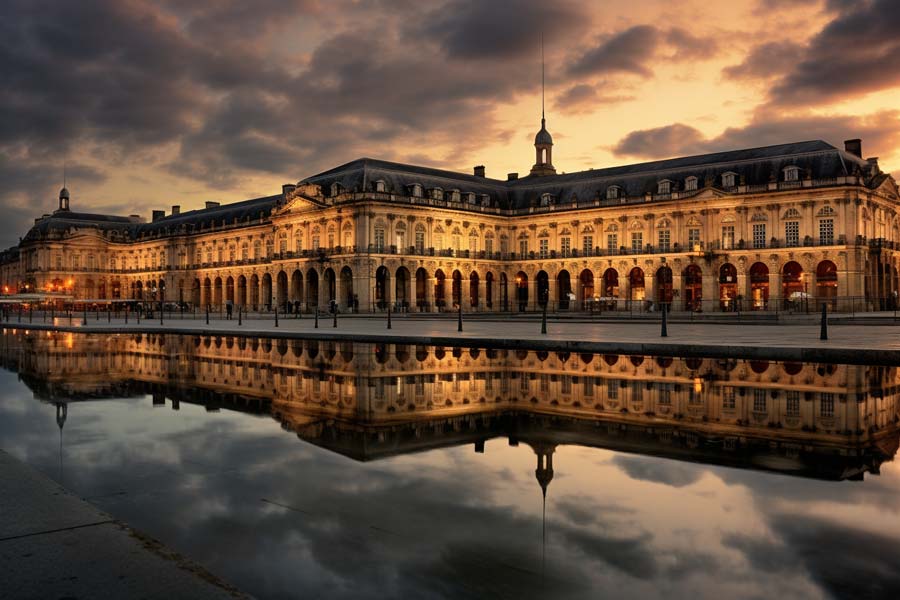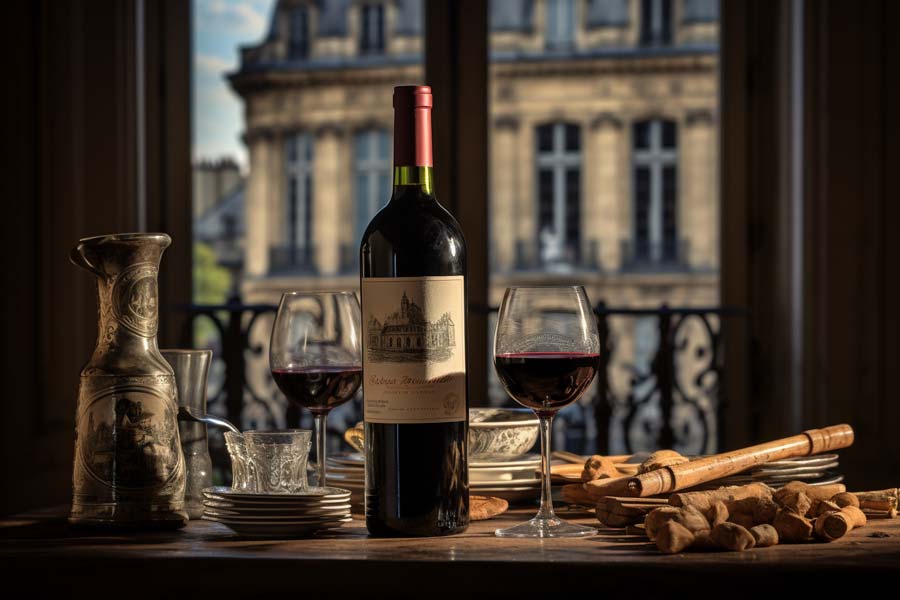[NOTE: This post comes from Deep into the 5 Best Posts From ‘Wine Grapes A Complete Guide’!]
In the realm of global winemaking, there exists a singular name that exudes iconic status: Bordeaux. This renowned region weaves a captivating tale not only through its exceptional wines but also via its diverse array of Bordeaux wine grape varieties.
When one thinks of French wines, Bordeaux red wine often takes the forefront. It serves as a testament to the region’s expertise and the richness found within the Bordeaux wine grape variety.
Bordeaux’s charm encompasses more than just its own grape varieties. It sparks curiosity about the connection between Bordeaux and other renowned regions.
Many people cherish the legacy of Burgundy grapes, appreciating their rich tapestry of flavors and historical significance. However, when compared to the Bordeaux wine grape variety, an intriguing contrast and narrative emerges.
The intertwining of these two renowned regions delves deep into the viticultural richness of France, offering wine enthusiasts a profound understanding.
Every Bordeaux grape has received meticulous nurturing, revered celebration, and expert craftsmanship. These elements set apart this exceptional red wine, making it an exquisite delight for wine enthusiasts.
The blend itself is truly captivating, extending beyond the individual grape varieties. It is within the Bordeaux blend grapes that a magical transformation occurs, elevating good wine to a realm of ethereal beauty.
In crafting this exquisite blend, it is not just a haphazard combination, but rather a meticulously orchestrated symphony. Each Bordeaux wine grape takes on its designated role in an elegant dance, culminating in a harmonious finish.
Embarking on this journey means embracing a world of rich flavors, captivating history, and profound passion. It offers an immersive experience into the soul of French winemaking, where the Bordeaux wine stands unrivaled in its supremacy.
Before delving into the historical essence and art form of Bordeaux, take a moment to reflect on the Bordeaux wine grape variety. It is the soul of what defines Bordeaux itself.
Table of Contents
Bordeaux’s Historical Essence

Bordeaux stands as a remarkable testament to the passage of time and cherished traditions. The history of Bordeaux wine is intricately entwined with the land it hails from and the vibrant community that nurtures it.
The wine region of Bordeaux has experienced numerous seasons, each contributing to its rich history. From humble vineyards in the past to expansive estates today, the journey has been truly transformative.
During its early days, Bordeaux predominantly exported grape juice made from the region’s own grapes. This modest origin laid the groundwork for what eventually bloomed into the world’s most renowned wine region.
The journey from grape juice to refined wine brought about a remarkable transformation. A significant catalyst for this metamorphosis was the meticulous selection of the Bordeaux Wine Grape Variety.
Bordeaux stands apart from other regions due to its truly unique blend. Referred to worldwide as the “Bordeaux blend,” it consists of a harmonious concoction of different grape varieties.
The Bordeaux blend is a true embodiment of synergy, where the different grape varieties work together harmoniously, enhancing each other’s unique strengths and flavors. In this dynamic collaboration, the Bordeaux grape shines brightly.
Throughout the centuries, the Bordeaux wine region has impeccably maintained its distinctive taste. This remarkable flavor is a testament to the unwavering commitment of its dedicated winemakers and the abundance found within their selection of wine grapes.
Bordeaux’s historical essence unfolds as one embarks on a captivating journey through its past. A vibrant narrative awaits, unveiling the humble beginnings of grapevines that ultimately transformed into the defining force behind an entire region.
Bordeaux’s Wine: An Art Form

The essence of winemaking in Bordeaux goes beyond its mere production; it is an extraordinary art form deeply entrenched in the rich grape.
Many wine enthusiasts often question the reason behind Bordeaux’s reputation as the finest. The answer lies within its rich tapestry of history, remarkable terroir, and unwavering dedication to crafting exceptional wines.
Every bottle of Bordeaux wine contains a compelling story, deeply intertwined with the rich tapestry of Bordeaux. It encapsulates centuries of cherished tradition and heritage.
To truly grasp the artistry of Bordeaux, one must explore the intricate details of its terroir. The soil composition, climate patterns, and overall environment each contribute significantly to the exquisite flavors that emerge in every sip.
Then, the influence of the master winemakers takes center stage. These dedicated artisans, with their unmatched expertise, skillfully draw out the finest qualities from the Bordeaux grape.
In the realm of global wine, Bordeaux has established itself as an unparalleled standout. Its reputation, fortified by the exceptional Bordeaux Wine Grape Variety, proudly remains unmatched.
Art, being a subjective realm according to popular belief, becomes an exception when it comes to Bordeaux wine. The global community unites in solemn acknowledgement of its exquisite qualities and craftsmanship.
From vineyard to glass, Bordeaux wine embodies the essence of elegance. It represents the purest artistic expression of the renowned Bordeaux Wine Grape Variety.
Bordeaux’s Terroir: The Land and Climate Influence
Bordeaux holds a legendary status in the wine world due to its prestigious reputation. One significant factor contributing to this esteemed standing is its exceptional terroir.
The Bordeaux wine region holds more significance than a mere geographical marker. It represents an intricate tapestry woven with diverse soils, climatic conditions, and geological nuances.
Terroir, a French term, embodies the fascinating union of soil and climate. In Bordeaux, this harmonious relationship paints a vivid picture of the distinctive character found in each and every wine.
The range of soils found in this region varies from limestone to gravel, with each type imbuing unique characteristics. These diverse ground variations play a vital role in nurturing the Bordeaux grape in an exceptional way.
Bordeaux’s maritime climate contributes significantly to the flourishing of its vines. The moderate temperatures and abundant rainfall provide an ideal environment for their growth, setting the stage for a thriving vineyard.
However, smooth sailing is not always the case in the Bordeaux wine region. Occasionally, vineyards face the challenge of frost.
However, adversity often gives rise to brilliance. These challenging circumstances have only sharpened the adaptability of the Bordeaux wine grape.
The Gironde estuary, cutting through the region, contributes an additional element to the terroir. Its moderating influence plays a vital role in grape maturation.
The Bordeaux wine region’s terroir can be likened to a symphony—an exquisite composition born from the harmonious blend of land and climate. It is this unique combination that gives rise to wines of unmatched distinction,
Pioneering Producers in Bordeaux Wine Culture
Bordeaux boasts a rich legacy that extends beyond its exquisite land; it encompasses the dedicated individuals who nurture it. Throughout centuries, this remarkable region has witnessed the emergence of countless visionary producers.
These innovative winemakers brought forth new techniques to revolutionize Bordeaux wine culture. Through their bold experimentation with different grape varieties, they successfully transformed the traditional landscape.
The introduction of new grape varieties posed a risk. However, it turned out to be a pivotal decision that brought diversity and richness to the region’s oenological tapestry.
The region’s trademark has long been the traditional Bordeaux blends. However, the introduction of these new grape varieties brought a contemporary twist to the age-old blend.
Château owners and winemakers, both old and new, are the foundation of Bordeaux. Their collective efforts have propelled Bordeaux wine to its legendary reputation.
Bordeaux wine has always thrived on the synergy it embodies. The combination of various grapes in the bordeaux blend reflects this harmonious collaboration between flavors and characteristics.
Modern Bordeaux producers demonstrate a strong commitment to environmental consciousness. They have seamlessly integrated sustainable practices into the very fabric of wine production in Bordeaux.
These vintners, with their deep appreciation for tradition and willingness to embrace innovation, demonstrate a profound understanding of the importance of preserving heritage in Bordeaux’s winemaking. Their commitment ensures that
In conclusion, the wine producers of Bordeaux emerge as the unsung heroes of this enthralling narrative. Their unwavering commitment and profound passion shape the very essence of Bordeaux’s renowned wines.
The “7 Mysteries of Bordeaux Wine Grape Variety Brilliance”:
- The rich legacy and historical essence of Bordeaux’s wines.
- The artistry behind Bordeaux wine-making.
- The influence of Bordeaux’s unique terroir (land and climate) on its wines.
- The pioneering producers that shape Bordeaux’s wine culture.
- The distinctiveness and specialty of Bordeaux’s grape varieties in comparison to others like Burgundy grapes.
- The connection and blend of new grape varieties in Bordeaux’s wine tradition.
- The unmatched characteristics and profile of Bordeaux red wines.
FAQs
What are the 3 big grapes of Bordeaux?
The Bordeaux wine region is home to three major grapes: Merlot, Cabernet Sauvignon, and Cabernet Franc. These grapes play vital roles in the renowned blends of Bordeaux and dominate its vineyards. While Merlot thrives on the Right Bank, Cabernet Sauvignon takes charge on the Left Bank. As for Cabernet Franc, it often complements many blends in this illustrious wine region.
What are the 7 Bordeaux grapes?
The seven Bordeaux grapes are highly esteemed in the world of wine. They comprise Merlot, Cabernet Sauvignon, Cabernet Franc, Petit Verdot, Malbec, Carmenère, and Sémillon. These exceptional varieties include both red and white grapes and form the bedrock of Bordeaux’s renowned wine blends. While the first six grapes shine in red wine production, Sémillon plays its role as a white grape that often melds harmoniously with Sauvignon Blanc to craft Bordeaux’s flavorful white wines.
What is the main grape of Bordeaux wine?
Merlot, the primary grape of Bordeaux wine, holds a prominent position in the region. It reigns supreme on the Right Bank, lending its softness and richness to the wines crafted there. This grape’s excellence can be attributed to its adaptability to the region’s climate and its ability to produce approachable young wines that age gracefully over time.
What are the 5 red grapes of Bordeaux?
The primary red grapes of Bordeaux consist of five varieties: Merlot, Cabernet Sauvignon, Cabernet Franc, Petit Verdot, and Malbec. These grapes serve as the foundation for Bordeaux’s renowned red wines. Each grape contributes unique characteristics and complexities to create exceptional blends that are celebrated worldwide.